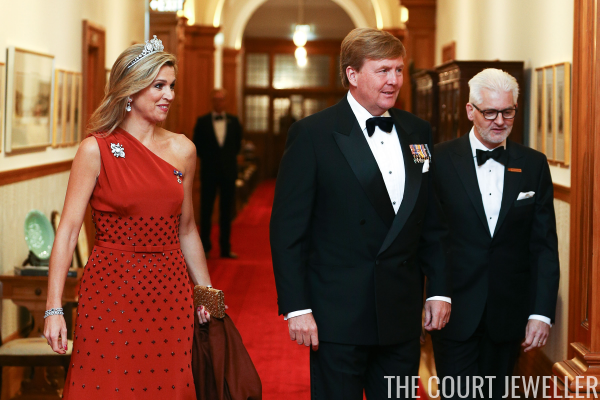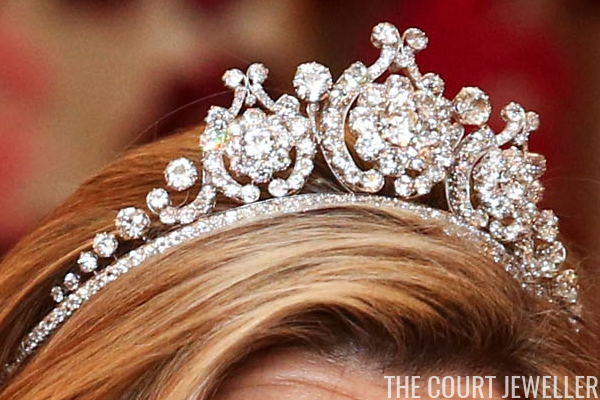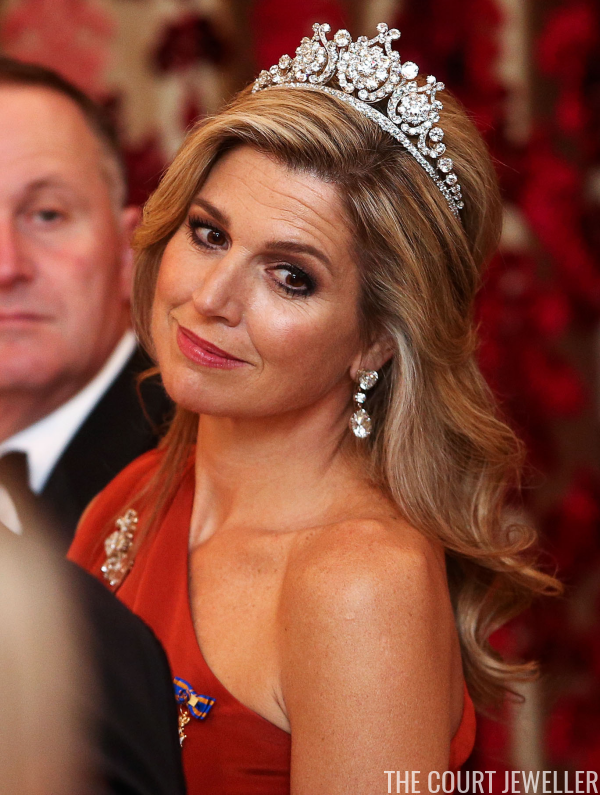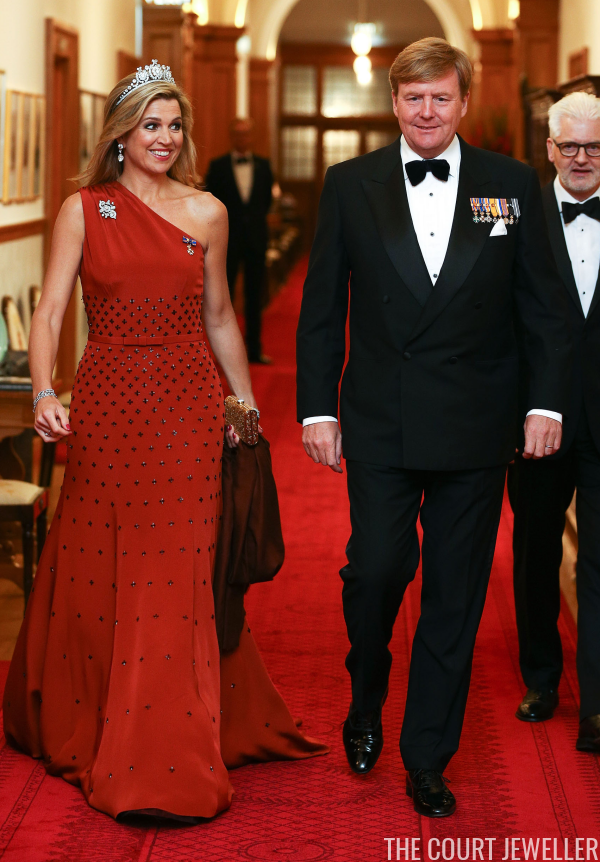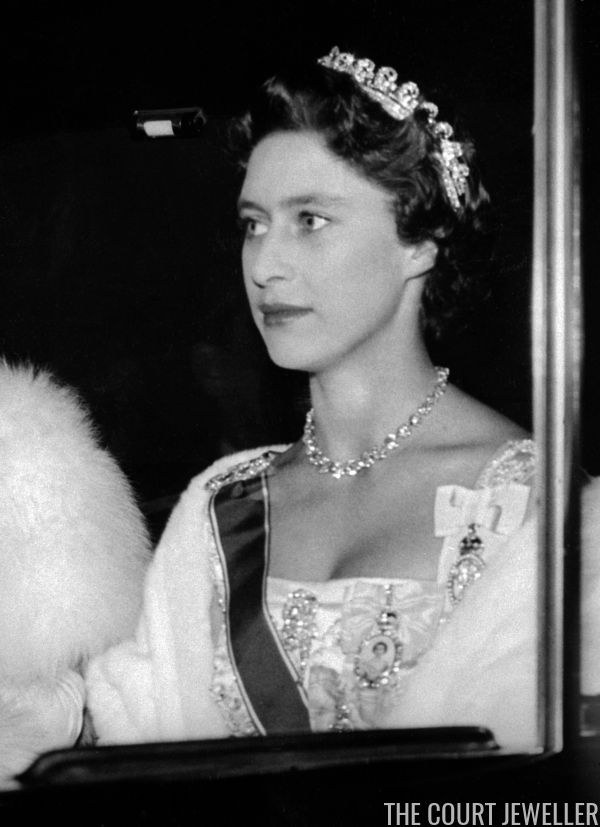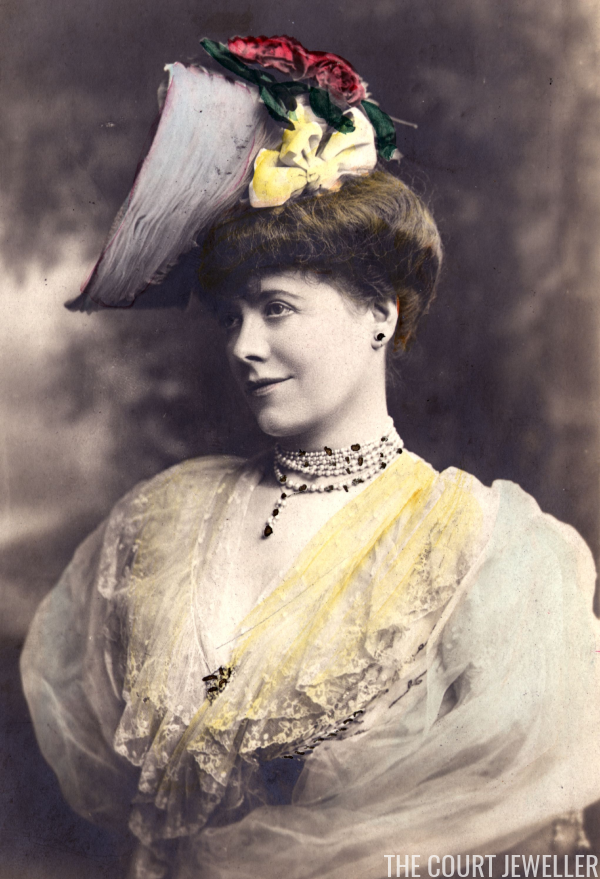 |
| Mrs. George Alexander, ca. 1907 [Photo: Hulton Archive/Getty Images] |
The whole round earth is ransacked for jewels to fill milady’s boxes and to add by their glamour the finishing touch to her dainty toilettes. Nowhere in the world are more exquisite specimens of artistic workmanship, or more costly gems, so lavishly displayed for the inspection of anyone who cares to view them as in our own Fifth Avenue jewelry district. A visit to these establishments is a delight to anyone who appreciates intrinsic beauty, combined with exquisite workmanship, while, here and there, one comes across novel effects in settings or combinations that make special appeal to people who like thing that are distinctly different from the ordinary styles. For others, the revival of old-time forms in watches and other articles has a quite irresistible charm, because of their delicate quaintness, or on account of their artistic merit.
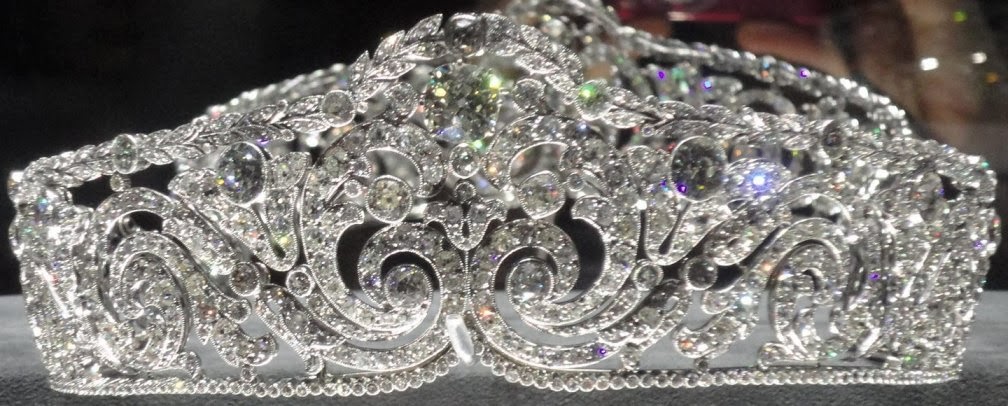 |
| A tiara featuring the millegrain technique, made by Cartier for Queen Elisabeth of Belgium [Photo: Nancy (see more here!)] |
Much of the beauty of the newest specimens of the lapidary’s art in the various articles of jewelry that are made up of combinations of the small stones that in their gleaming delicacy imitate nature’s frost work, is due to the new “millegrain” settings. These do not detract one iota from the stones, which they nevertheless hold quite as securely as did the older style setting. In the best specimens of the new pieces, one sees only the stones, and many of the forms in which they are made up are unusually delicate.
In the case of a celebrated jeweler, I saw brooches where the characteristic figures of Duchess and point laces were faithfully reproduced in form and delicacy, but with an additional brilliancy that made their transfiguration most fascinating.
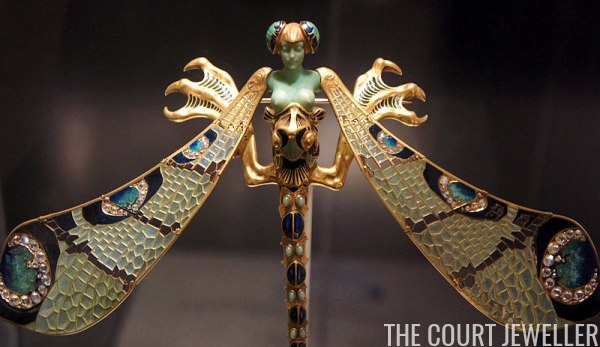 |
| An art nouveau dragonfly brooch by Rene Lalique [Photo: Wikimedia Commons] |
An ornament that could be employed at will for the decoration of the corsage or worn in the hair was a huge butterfly, his body made of opals with milky rainbow tints and shadowy red firelights in their gleams. The wings were all of small diamonds, set in close order, yet in such fashion that the slightest movement caused each separate part to tremble, producing coruscations of a brilliancy impossible to describe. Rubies of fair size made the dots that imitated nature’s markings on the wings, and the eyes and antennae were also brought out by the use of colored stones.
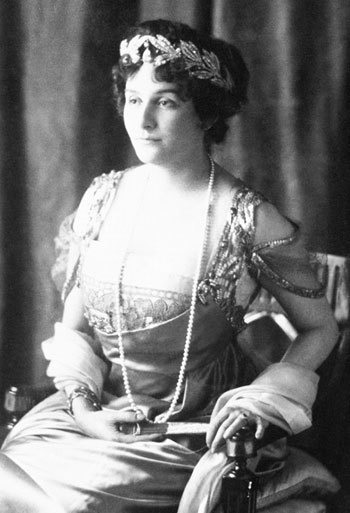 |
| Princess Marie of Greece and Denmark wears a diamond tiara made in 1907 by Cartier [Photo: Grand Ladies Site] |
Tiaras and necklaces made after the same lovely fashion were, as usual in such pieces, separable into other forms, their ornaments detachable for any use that might be desired.
While conservative people investing considerable sums in diamonds still cling to aggregations or single stones that are solely composed of the diamond, the use of sharp contrasts is rather more smartly endorsed at present. This is particularly true in the smaller brooches and bars, as well as in the pendants, for which there continues to be great demand.
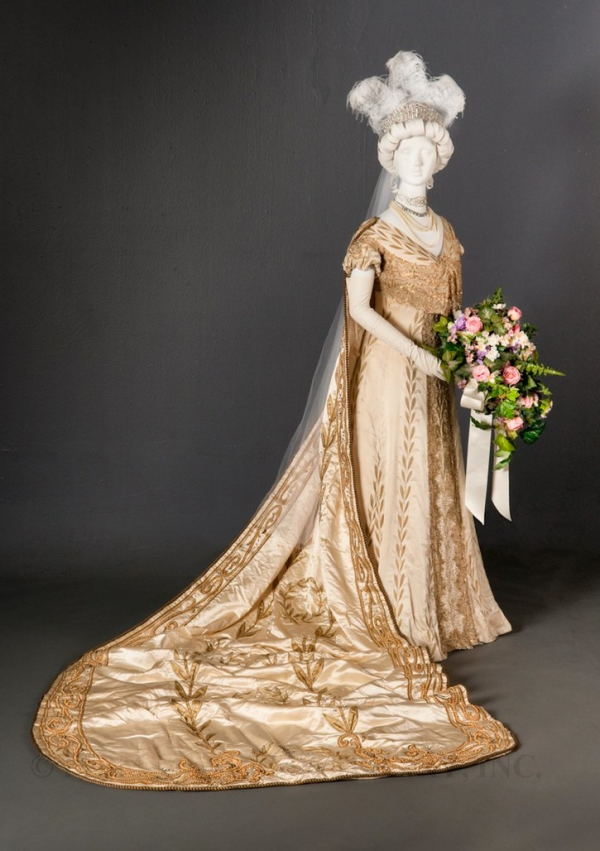 |
| An example of British court dress from 1907, including veil, feathers, and jewels [Photo: Grand Ladies Site] |
Square cuttings, or “colabra” settings, are also fashionably endorsed and are responsible for some of the most effective pieces displayed. A long bar, measuring some six inches, designed for holding the flowers that would ornament the corsage, was made of square-cut emeralds, with a large circular diamond set midway of its length.
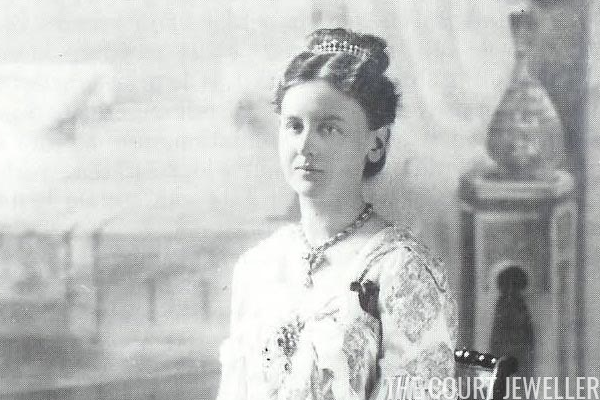 |
| Queen Wilhelmina of the Netherlands wears her diamond haircomb, ca. 1903 [Photo: Grand Ladies Site] |
Combs studded with precious stones are rather more liked than are the more pretentious “crowns” of many forms that women in this democracy have appropriated after a rather indiscriminate fashion; not that tiaras have gone out by any means, only that, just now, it is said their owners rather prefer to wear them in less impressive forms. Perhaps the reason for this lies in the fact that these ornaments are more glittering than becoming or comfortable, for women generally are coming to recognize that no article or garment adds to their attractiveness unless it is donned and worn with the graceful ease that is impossible where a sense of physical or mental discomfort prevails.
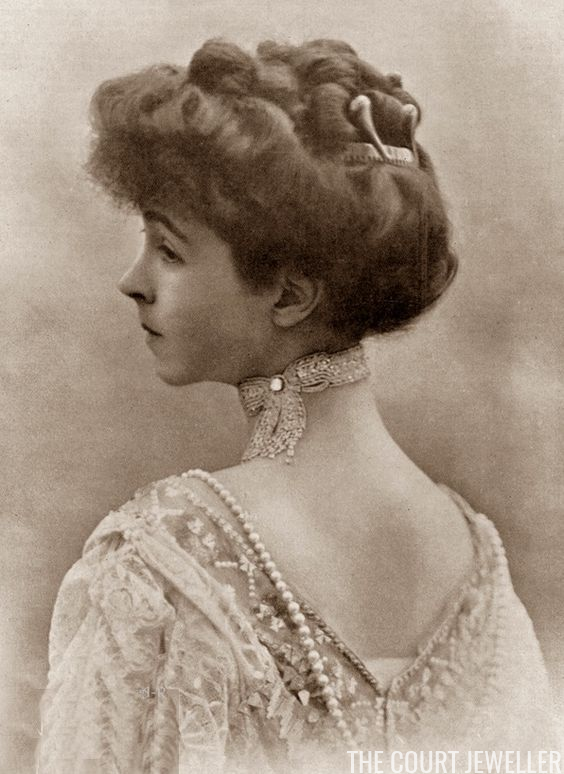 |
| Consuelo Vanderbilt, the famed Duchess of Marlborough, wears a ribbon choker |
Among the small novelties for everyday wear the dog collar of black velvet ribbon with a sliding clasp set with coral, jade, topaz, or turquoise is a prime favorite, especially with the younger set. These same velvet ribbons ornamented with sets of slides in gold or silver with or without stones are also popular and make pretty birthday gifts for schoolgirls, while a brand-new cravat pin for adjusting and ornamenting the square cravat, worn with embroidered collars, will go straight to the heart of any girl who sees or owns it.
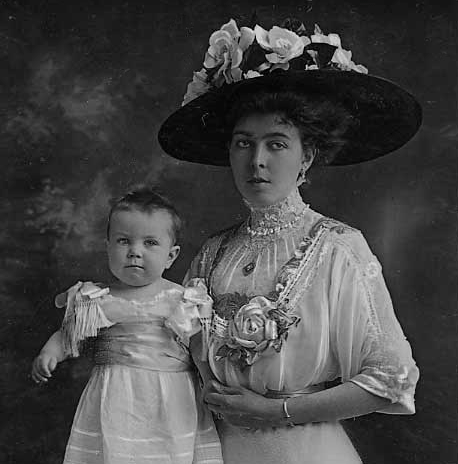 |
| Crown Princess Margareta of Sweden wears her famous gold bracelet [Photo: Grand Ladies Site] |
There is no sign of waning in the demand for bracelets, and jewelers report that, on the whole, bangle forms are preferred. These may be had from pretty, plain affairs to those made with square-cut stones set close together and punctuated at intervals with larger jewels in contrasting tints.
Flexible bracelets revive all the old time forms, including the spiral snakes with jeweled eyes that appeal to a few women. Some made of flat squares of wrought gold, hinged ornamentally, have as a finish a very Japan-esque dragon’s head with jeweled settings. As long as sleeves continue short, there will be a demand for bracelets that can be worn pretty generally, which is as good as saying that bracelets are sure to be in style for a considerable time to come.
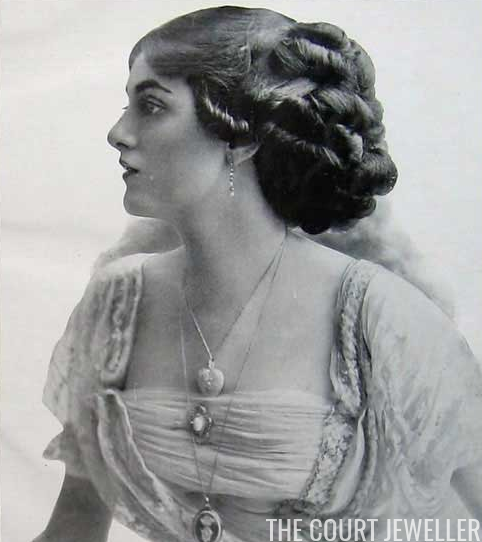 |
| Sylvia, Countess Poulett wears a pair of pendant necklaces, ca. 1908 |
Necklaces of odd form in wrought gold or silver set with jade, amethyst, topaz, and coral are decidedly faddish for general wear, while for more formal use, dog collars of close-set stones, and fine gold chains that hold artistic-looking pendants, are favorites.
What are technically known as semi-precious stones are very much used by even the most exclusive trade, and mounted, as these are, with rims and settings of small diamonds, they frequently outshine and surpass in cost more modest specimens of the first-grade jewels, such as rubies, diamonds, emeralds, sapphires, and pearls. An aquamarine, a large square-cut stone, set in a rim of diamonds, was $2800, though this stone belongs distinctly in the “semi-precious” class.
Cameos are as fashionable as in our grandmother’s day, and make up charmingly for collars, bracelets, and pendants, as well as in many other forms. Lapis lazuli is also in considerable demand for brooches and for necklaces, while coral has come back again, and accords particularly well with the same color as used in fashionable trimmings and accessories.
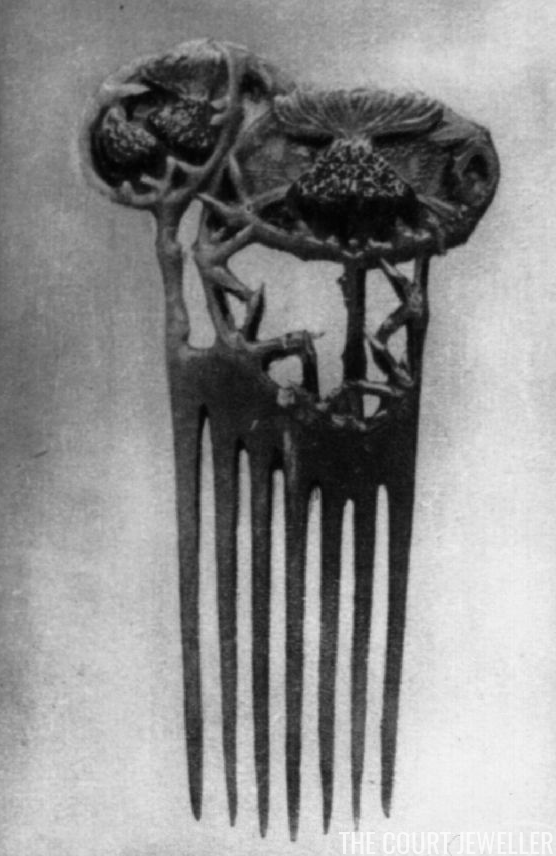 |
| A carved art nouveau comb from the collection of actress Sarah Bernhardt [Photo: Hulton Archive/Getty Images] |
Carved tortoiseshell and amber are the favorite materials for making up the combs that are a necessary part of every woman’s coiffure equipment, and some of these surpass in attraction the more pretentious combs set with gold and stones, though many of these latter are very desirable additions to the coiffure for semi-formal wear.
Very thin, open-faced watches are the newest revivals of an old fashion. I saw a rather large but very thin specimen of this class for a man’s use that was only one-sixteenth of an inch in thickness, and was assured that it contained a fine Swiss movement and was an excellent timepiece. The women’s watches were like small lockets, and these also had Swiss movements and were said to be constructed to keep the time of day, even though they are allowed to swing loose at the end of a jewel-studded chain, after the present faddish fashion. Whatever the question of their use, these small watches are decidedly ornamental, with their delicate enamels and stone settings, and people who buy them can probably have other means of knowing what time it is.
